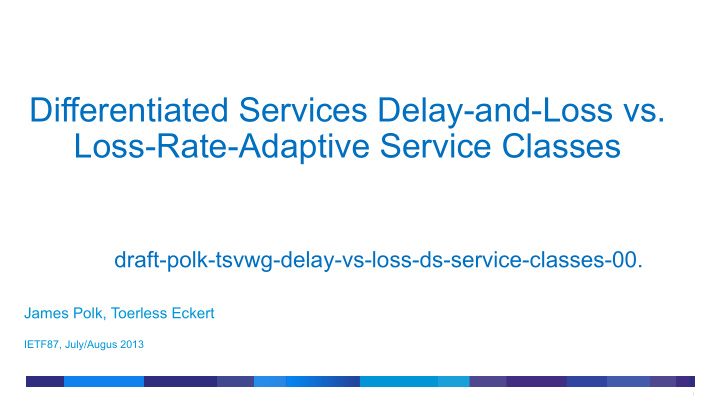



Differentiated Services Delay-and-Loss vs. Loss-Rate-Adaptive Service Classes draft-polk-tsvwg-delay-vs-loss-ds-service-classes-00. James Polk, Toerless Eckert IETF87, July/Augus 2013 1
• Likely target goals for RMCAT style traffic and RMCAT congestion control Low Delay/Jitter requirements Downspeed before congestion loss (if possible). Sender rate controlled (less bursty in sending than receiver window based congestion control) May survive limited random/burst-accumulation loss without retransmission (interpolation/FEC/…). • Problems with competing traffic • Internet: Default/Best-Effort: TCP traffic • Most TCP still loss based • Even delay sensitive TCP flow control creates more jitter/delay (receiver based window control) • Controlled networks: • Assume Multimedia Conferencing (MMC) / AF PBB Group is best-fit Service-Class/PHB group for RMCAT type traffic ?! • Problem: existing, Non-rate adaptive eg: video-conferencing traffic in MMC (primarily AF41) Often assumes “admission-control” that often is badly/lazily deployed • “Overprovisioning” that can not keep up with changes in reality (new apps, users, busy-hour changes,…) • If rate-controlled, it is more “circuit-breaker” in nature – stop/downspeed after 1min/30 second loss. 2
• MUST work in best-effort-queue/Internet (TCP, non-delay sensitive RTCweb flows, …) • But can likely not explore best behavior there (see previous slide). • SHOULD be made to work best in the absence of incompatible competing traffic • Controlled environments: • Service Class choice should maximize benefit and likelihood/ease of adoption. • Known issue: Today, MMC / AF4 PHB Group can be worse than Standard (BE) in controlled networks (traffic abusing it). • Open questions (from discussion on mailing lists) • Is MMC the appropriate Service Class for this traffic (ignoring that its commonly used DSCP/PHB group may not be) ? • What other non-RMCAT traffic would be sufficiently compatible to be in the same service-class • Work also relevant for “Internet” : • Persistent congestion primarily an “edge” problem • Home<->Broadband-access, Wireless/Mobile (802.11/3G/4G) access • “Controlled Network” choices can be applied here as well • Related efforts (Metadata/PCP/STUN/RSVP) to simplify classification as in controlled networks if DSCP is a problem. 3
• Core suggestion Separate RMCAT style loss/delay sensitive/rate-adaptive media from existing traffic using AF4. Assign appropriate DSCPx for RMCAT style traffic. • Assumes MMC Service Class / AF4 PHB is correct for this traffic. Just the actual DSCP is abused. If that is not the correct assumption, then we should define better PHB/Service-Class. • Keep AF4x as it is deployed today Not ideal… but no money in fixing bad legacy deployments. • Use CS4 as DSCPx for RMCAT style traffic Any better recommended DSCP ? • Add DSCPx-discardable Goal: AF42/AF43 DSCPx/DSCPx-discardable 4
• Todo: Revisit what “RMCAT” type classic includes Eg: RMCAT + LEDBAT ? Class should be defined by delay requirements, not congstion control algorithm. • From RFC4594bis: Permit (not demand) voice part of RMCAT sessions into EF Audio often not well rate-adaptive and often more important than video DSCPx (video) + EF(Audio) likely resulting in better experience under congestion: Audio more likely more loss sensitive than video. Burst collision loss in DSCPx will not affect audio. 5
6
Recommend
More recommend